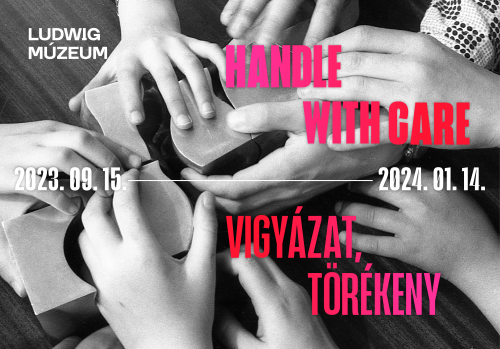"The ladder to the world” - the RomaMoMA Nomadic Library feat. Romani Design is an interactive installation was created in the spirit of functionality, adaptability, and activism, as a conceptual, site-specific extension of the exhibition titled 'Handle with Care' at the Ludwig Museum. The exhibition is the many meanings of caring, exploring its essence and various layers.
Romani Design is the world's first Roma fashion studio: the founding designers, Erika Varga and Helena Varga, have been engaged in activist and creative activities in the fields of fashion, applied arts, community development, and music for more than 13 years now, applying the traditional elements, motifs, and fashion as a communication platform, using a comprehensive, interdisciplinary method. The designers' activist attitude is present in all their work, projects, and partnerships: placing Roma clothing culture where it rightfully belongs, creative work based on sustainable fashion and upcycling principles, and messages aimed at society, including an emphasis on social responsibility and the power of knowledge - all these make the creative duo authentic and experienced representatives of the contemporary creative industry.
Now Ludwig Museum houses their latest installation, which is connected to the RomaMoMA Nomadic Library created by ERIAC and OFF-Biennále Budapest. RomaMoMA symbolizes the theory of a museum exhibiting contemporary Roma art: since the founding, Romani Design has been supporting and building the prestige of Roma culture and clothing culture nationally and internationally. This has been achieved through numerous museum partnerships, independent exhibitions, and fashion collections presenting Roma clothing culture in contemporary context.
The starting point of their current artistic concept, created in collaboration with interior designer dr. Beatrix Torma, was the practical usability of the installation and its potential for continued use following the project's completion, in line with modern museum practices and environmental consciousness. The central element of the installation is a structure consisting of two ladders with shelves: the ladder symbolizes progress, efficient work, and the journey between Earth and the sky. The ladder is a bridge, a connecting point among the fragmented communities of our world. It reflects on the designers' views on the absence of a unified, conventional written form of the Romani language, as well as the extent and quality of academic representation.
Within the project, 6 large-scale assemblage textile paintings were created using handmade patchwork techniques, unique Romani Design prints, and vintage materials, attached to the fabric used in bookbinding. The images are in relation to the exhibition's theme and the cultural mission represented by Romani Design. The images include, among other things, the international Romani anthem "Gelem Gelem" with lyrics in the Hungarian language written by Varga Helena, portraits of outstanding deceased Romani artists in the field of Hungarian culture, excerpts from the animated series titled "Cigánymesék" (Gypsy Tales) by the Kecskeméti Filmgyár, details related to Marian Devotion, building on both written and visual codes in their impact mechanisms.
In the twenty-first century, a library serves not only as a temple of knowledge acquisition but also functions as a communal space: the creators of Romani Design enhanced the ladder installation with their own designed textiles, complementing the existing furniture in the library: the graphic design of the tablecloths were designed by Zalán Péter Salát.
Lili Kriston - Romani Design





































